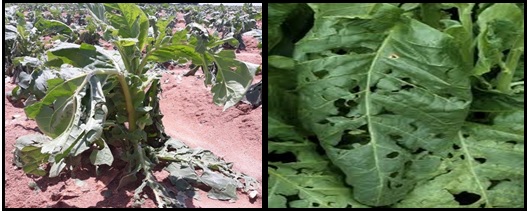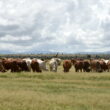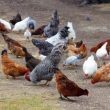Chinaniso Chibudu
Tobacco Research Board, Kutsaga Research Station, P. O. Box 1909, Harare, Zimbabwe
1. Introduction
In the face of climate change, agricultural production is becoming increasingly vulnerable to climate variability. In Zimbabwe, hail storm crop damage is one of the major risks that can lead to substantial losses. While all adverse weather conditions present risk, hail is unusual because it is difficult to predict and is capable of obliterating crops in minutes. The damage inflicted on tobacco includes mottling of the leaves and stems (Fig. 1).

In addition, the stalks may be broken and the leaves may be punctured or whole plants destroyed to a point of getting no returns. The level of yield loss from hail depends on the strength of the storm, the size of the hail stones and the stage of the crop growth. Thus, post the occurrence of a hail storm, an immediate assessment of l damage has to be carried out for an informed decision on how best to manage the crop.
Although hail storms are a natural phenomenon and thus cannot be prevented, proper crop management post the hail storm can reduce the level of losses incurred. This article discusses how hail damaged tobacco crops can be managed in order to minimize losses for the grower.
2. Hail storm crop damage and its management
Ideally, all growers should insure their crops against hail damage. Crop insurance is essential, especially now when climate change has brought about unexpected weather conditions and greater risks. Hail insurance will ensure the grower recoups incurred costs and should the hail damaged crop recover or is successfully rehabilitated, that can then be an added bonus to the grower.
2.1 Management of hailstorm damage following loss of entire plants
Where there is hail-induced total crop destruction in the first three weeks of planting, replanting should be considered provided seedlings for replanting are available. If hail damage occurs late in the season (December onwards), replanting should not be considered because the crop might fail to reach maturity and may be prone to viral diseases such as potato virus Y (PVY) and Bushytop. In addition, there is a marked decrease in yield with late plantings.
2.2 Management of plants stripped off leaves but the bud not damaged
If all or nearly all the leaves are damaged and stripped off the plant save for the bud at the early plant growth stages, it is prudent to just remove the damaged leaves and let suckers develop. Any leaf portions attached to the mother plant should be left on the stalk so that food from such leaves can be used by developing leaves.
In the late stages of plant growth, it is not economic to maintain plants with almost all the leaves destroyed even though the bud remains undamaged, since only a few leaves will develop and be reaped at maturity. The best option in such a case is to leave a sucker to grow out of a cut stalk.
2.3. Management of hail damage on plants a few weeks after transplanting
Plants affected by hail within a few weeks of planting (Fig. 2) have a high probability of surviving and recuperating even if the bud is broken off and therefore, the plants should be left as it is and then let the plants develop suckers. Thereafter, a vigorous sucker is selected and allowed to grow while the rest are manually removed by hand. It is worthy to note that there is a progressive decline in yield and quality with increasing crop age when the damage occurs because of the greater number of leaves damaged.

2.4 Crop leaf affected when crop is near topping or when topped
If the crop is affected by hail when it is near to topping then the plant top can be cut down to below the damaged leaves (a process called ratooning). Additional fertilizer should be applied and this depends on the crop growth stage (Fig. 3) and time of the growing season. If tobacco is ratooned between 7-8 weeks after planting additional basal fertilizer should be applied. Additional nitrogen should be applied according to crop developmental stage (3-5 weeks after planting or near to topping time and the season. The success of ratooning depends largely on the time of the year that the hail occurs and whether a suckercide had been applied or not. Crops that are ratooned early in the season produce a high yield of good quality tobacco. Ratooning as late as December does not give satisfactory results and more so when disease prevalence is high depending on the season (wet or dry). Crops that have been topped and suckercide applied do not usually produce high yield and good quality. This is because the suckercide prevents good sucker growth.

2.5 Management of severe stalk breakage
A high proportion of stalk damage which occurs early in the growing season can be treated in two ways depending on whether seedlings for replanting are available and whether the plants had well established or whether there is adequate moisture and how big the plants are. In a situation where the plants had not established well and when there is not enough moisture, it is better to replant than to keep the frail plants. The replanted crop will be able to grow to maturity and attain favourable yields and quality since it will be early in the season. Supplementary irrigation will enhance crop growth if soil moisture is not adequate in a situation where replanting was done. One other way of managing the severe stalk breakage, if the plant establishment is good is to allow sucker growth from a stalk cut at least to a height of 15-20 cm in order to have adequate strong suckers from which one sucker on each plant becomes the main stalk for leaf development. Torn leaves remaining on the damaged plants should not be removed however they are left to provide a source for nutrients for enhancing sucker growth.
- Disease Management
Hail damaged crops are susceptible to various fungal and bacterial diseases such as angular leaf spot and alternaria leaf spot. Thus, treatment with a plant immune boosting crop protection agent such as Acibenzolar-S-methyl (Bion) is essential to prevent disease infection later in the season.
- Concluding Remark
The best option for growers to guard against losses from hail damage and other adverse weather conditions is crop insurance with reputable insurance companies.
For more information, growers are urged to contact the Tobacco Research Board’s Crop Production and Molecular Technologies Division on telephone # 086 8800 2604 or Email: tobres@kutsaga.co.zw or visit Kutsaga Research Station (Airport Ring Road).









